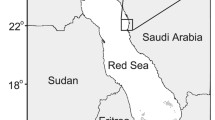Abstract
A random walk stimulation model was developed to explore the effects of variations in light regimes due to vertical mixing on primary productivity. Cells were allowed to light-shade adapt on some time scale by altering chl:carbon ratios in response to variations in light regimes. Photosynthetic response was adjusted according to variations in chl: carbon ratios by either varying the initial slopes of photosynthesis-irradiance curves, or varying photosynthetic capacities. The model suggests that despite physiological adaptation to light, vertical mixing may have little effect on the integrated water column primary productivity. It is suggested that if photoinhibition does not have a pronounced effect, the average distribution of primary production in a water column is not related to variations in light regimes arising from turbulent diffusion processes.
Similar content being viewed by others
Literature Cited
Bogorad, L.: The biosynthesis of chlorophylls. In: The chlorophylls, pp 481–510. Ed. by L. P. Vernon and G. R. Seely. New York: Academic Press 1966
Falkowski, P. G.: Light-shade adaptation in marine phytoplankton. In: Primary productivity in the sea, 531 pp. Ed. by P. G. Falkowski. New York: Plenum Press 1980
Falkowski, P. G. and T. G. Owens: Light-shade adaptation: two strategies in marine phytoplankton. Plant Physiol. 66, 592–595 (1980)
Falkowski, P. G.: Light-shade adaptation and assimilation numbers. J. Plankton Res. 3, 203–216 (1981)
Fleischhacker, P. and H. Senger: Adaptation of the photosynthetic apparatus of Scenedeamus obliquus to strong and weak light conditions. Physiol. Plant. 43, 43–51 (1978)
Herron, H. A. and D. Mauzerall: The development of photosynthesis in a greening mutant of Chlorella and an analysis of the light saturation curve. Plant Physiol. 50, 141–148 (1971)
Marra, J.: Effects of short-term variations in light intensity on photosynthesis of a marine phytoplankter: a laboratory simulation study. Mar. Biol. 46, 191–202 (1978a)
Marra, J.: Phytoplankton photosynthetic response to vertical movement in a mixed layer. Mar. Biol. 46, 203–208 (1978b)
Myers, J.: Culture conditions and the development of the photosynthetic mechanism III. Influence of light intensity or cellular characteristics of Chlorella. J. gen. Physiol. 29, 419–427 (1946)
Myers, J. and J. Graham: The photosynthetic unit in Chlorella measured by repetitive short flashes. Plant Physiol. 48, 282–286 (1971)
Plant, T., K. L. Denman, and A. D. Jassby: Modeling the productivity of phytoplankton. In: The sea, Vol. 6, pp 807–856. Ed. by E. D. Goldberg, I. N. McCave, J. J. O'Brien and J. H. Steele. New York: Wiley Interscience 1977
Pielou, E. C.: An introduction to mathematical ecology, p 126. New York: Wiley Interscience 1969
Prezelin, B. B. and B. M. Sweeney: Photoadaptation of photosynthesis in two bloom-forming dinoflagellates. In: The second international conference on toxic dinoflagellate blooms, pp 101–106. Ed. by D. L. Taylor and H. H. Selinger. New York: Elsevier 1979
Skellam, J. G.: Random dispersal in theoretical populations. Biometrika 38, 196–218 (1951)
Steemann Nielsen, E.: Marine photosynthesis, 141 pp. New York: Elsevier 1975
Author information
Authors and Affiliations
Additional information
This research was performed under the auspices of the US Department of Energy under Contract No. DE-ACO2-76CH00016 and partially supported by the International Decade of Ocean Exploration (IDOE), NSF, as part of the Coastal Upwelling Ecosystems Analysis (CUEA) program.
Rights and permissions
About this article
Cite this article
Falkowski, P.G., Wirick, C.D. A simulation model of the effects of vertical mixing on primary productivity. Marine Biology 65, 69–75 (1981). https://doi.org/10.1007/BF00397069
Accepted:
Issue Date:
DOI: https://doi.org/10.1007/BF00397069




